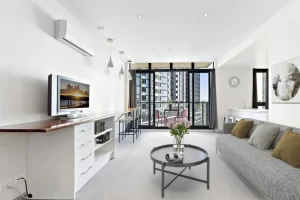Rental prices for apartments surged 10 per cent nationwide in the 12 months to June – the first double-digit growth for the sector, fuelled by dwindling supply and rising demand, data from CoreLogic shows.
Inner-city apartments across Melbourne and Sydney led the biggest rental gains, with West Melbourne, Docklands, and Southbank soaring by more than 31 per cent.
In Sydney, median rents for apartments in Ultimo, Zetland and Haymarket also rose sharply, jumping by 19.4 per cent, 17.2 per cent and 18.7 per cent respectively.
Unit rents continued to outperform houses nationwide over the past three months, rising by 3.5 per cent and 2.7 per cent respectively.
Kaytlin Ezzy, CoreLogic research analyst said rental demand for units and apartments had been surging since the start of the year as tenants sought out affordable options.
Over the COVID-19 period to date, house rental values have jumped by 18.8 per cent, which is nearly twice the rate of unit rental price growth at 9.9 per cent.
“Rental demand across the medium and higher density segment has surged throughout the first half of the year, partially driven by worsening affordability in the house sector,” Ms Ezzy said.
“Since March 2020 house rental values have increased at nearly twice the rate of unit rental values with the gap blowing out to 13.5 per cent in December 2021.
“It’s likely the gap in rental values will narrow further as rental demand continues to shift towards relatively more affordable higher density properties.”
Rental prices rose across all capital cities over the latest quarter and year-on-year, as did the individual house and unit markets.
The national rental index rose by 2.9 per cent over the June quarter to $526 per, to a record high, said Ms Ezzy.
“The rapid pace of quarterly rental growth has occurred despite the lack of overseas migration,” she said.
“This sustained period of strong rental growth has seen national dwellings record the highest annual growth in rental values since December 2008, when rental demand was supported by record levels of international migration.
“However, the current surge in rental demand has occurred largely in the absence of overseas migration and has instead been driven by factors including low supply and a decrease in the average household size which has amplified domestic rental demand over the COVID period to date.”
Demand likely to rise
Median rents for Sydney houses rose by 2.5 per cent and units by 3.7 per cent over the quarter. In the past 12 months, house rents climbed by 9.3 per cent and units by 10.3 per cent.
In Melbourne, median house rent lifted by 2.4 per cent and units by 3.7 per cent over the past three months. Over the year, house rents rose by 5.2 per cent and units by 10.9 per cent.
Adelaide was the country’s strongest rental market with house rents rising by 4.4 per cent and units by 3.9 per cent over the quarter. It is also the capital’s strongest quarterly rise in unit rents since March 2007, and the highest ever quarterly rise in house rents.
Canberra remains Australia’s most expensive capital city rental market with a typical house renting for $759 per week and a typical unit costing $573 per week.
Melbourne replaced Adelaide as Australia’s most affordable house rental market, with the typical house renting for $506.
CoreLogic Research Director Tim Lawless said rental demand was likely to gather steam as overseas migration picked up, however, affordability constraints may eventually limit the rate of growth.
“With the exception of Darwin, the strong rental growth seen over the past year has led dwelling rents across all of the capitals to reach new record highs,” Mr Lawless said.
“Despite growing affordability concerns, rental markets are expected to remain tight for some time yet partly due to a shortage of supply following a long period of low investment activity between 2015 and 2021, but also due to renewed rental demand as international migration recovers.
“Worsening affordability could have a negative impact on rental demand as more people try to minimise costs by maximising occupancy rates or reforming larger households. However, this will likely be offset by additional rental demand as international migration returns to pre-COVID levels.”
This article is from Australian Financial Review, please click the following link for the original article: https://www.afr.com/property/residential/apartment-rents-soar-more-than-31-pc-across-inner-melbourne-20220705-p5az55




